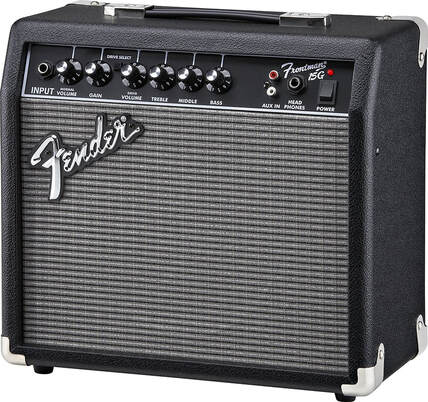Purchasing an Amplifier
This lesson is for people who are interested in purchasing an amplifier for a student. I will cover the basic differences quickly and cover the main concerns of why your decisions are important.
Adding an amplifier to use with any guitar that has a pickup requires some basic knowledge about the differences and variations of amplifiers available.
An electric guitar is generally designed for the sound produced to be generated by the strings vibrating over magnetic pickups which transfer the sound through the amplifier and out a speaker.
An acoustic guitar produces sound on its own from the vibrations of the stings being bounced through the body of the guitar and out the sound hole. This sound of course is limited in volume and distance it can travel. Some acoustic guitars have or can have an electric pickup installed allowing the guitar to be plugged into an amplifier for performance or recording.
Amplifiers vary in cost, size, and output power greatly. For most beginners a small 5, 10, or 15 watt amplifier is sufficient for home practice, and smaller performance spaces. A small amplifier can still vary greatly in cost depending on the brand and build specifications. Almost all have the ability to plug a headphone in for silent practice.
A small amplifier can be as low as $40 or $50 and can go into the hundreds of dollars. Generally a good quality small solid state amplifier will be under $150; many used are available for very low cost.
A good quality guitar cable is recommended to last and produce quality sound.
Amplifiers for acoustic guitars generally have less sound variation ability as they basically want to reproduce the clean sound of the guitar. Some have the ability to connect a microphone and line in to allow voice and/or music from an outside device to be played through the amplifier at the same time as the guitar.
Amplifiers for electric guitars generally have settings allowing the sound output to vary greatly from clean to dirty, distorted and or many other modulated sound choices. They generally do not have an input for microphone but often do have an external music source input feature.
Vacuum Tube amplifiers can be very desirable for the warmth and depth of sound they create but are generally much more expensive than solid state amplifiers. Solid state amplifiers generally require less maintenance and are less costly. Modern technology has made solid state amplifiers very reliable, compact and reasonably priced.
Adding an amplifier to use with any guitar that has a pickup requires some basic knowledge about the differences and variations of amplifiers available.
An electric guitar is generally designed for the sound produced to be generated by the strings vibrating over magnetic pickups which transfer the sound through the amplifier and out a speaker.
An acoustic guitar produces sound on its own from the vibrations of the stings being bounced through the body of the guitar and out the sound hole. This sound of course is limited in volume and distance it can travel. Some acoustic guitars have or can have an electric pickup installed allowing the guitar to be plugged into an amplifier for performance or recording.
Amplifiers vary in cost, size, and output power greatly. For most beginners a small 5, 10, or 15 watt amplifier is sufficient for home practice, and smaller performance spaces. A small amplifier can still vary greatly in cost depending on the brand and build specifications. Almost all have the ability to plug a headphone in for silent practice.
A small amplifier can be as low as $40 or $50 and can go into the hundreds of dollars. Generally a good quality small solid state amplifier will be under $150; many used are available for very low cost.
A good quality guitar cable is recommended to last and produce quality sound.
Amplifiers for acoustic guitars generally have less sound variation ability as they basically want to reproduce the clean sound of the guitar. Some have the ability to connect a microphone and line in to allow voice and/or music from an outside device to be played through the amplifier at the same time as the guitar.
Amplifiers for electric guitars generally have settings allowing the sound output to vary greatly from clean to dirty, distorted and or many other modulated sound choices. They generally do not have an input for microphone but often do have an external music source input feature.
Vacuum Tube amplifiers can be very desirable for the warmth and depth of sound they create but are generally much more expensive than solid state amplifiers. Solid state amplifiers generally require less maintenance and are less costly. Modern technology has made solid state amplifiers very reliable, compact and reasonably priced.

